[OS] Introduction
What is an Operating System?
- A program that acts as an intermediary between a user of a computer and the computer hardware
- Operating system goals:
- Execute user programs and make solving user problems easier
- Provide an execution environment in which a user can execute programs
- Make the computer system convenient to use (convenience)
- Use the computer hardware in an efficient manner (efficiency)
Computer System Structure
- Computer system can be divided into four components:
- Hardware – provides basic computing resources
- CPU, memory, I/O devices
- Operating system
- Controls and coordinates use of hardware among various applications and users
- Application programs – define the ways in which the system resources are used to solve the computing problems of the users
- Word processors, compilers, web browsers, database systems, video games
- Users
- People, machines, other computers
- Hardware – provides basic computing resources
Four Components of a Computer System
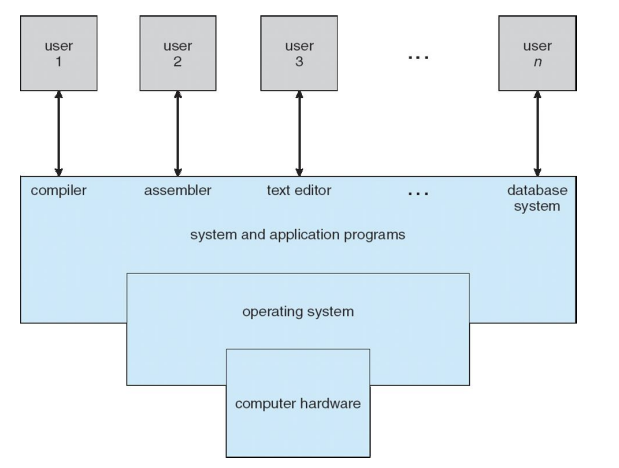
What Operating System Do
- Depends on the point of view
- Users want convenience, ease of use and good performance
- Don’t care about resource utilization
- But shared computer such as mainframe or minicomputer must keep all users happy
- 한 사용자만 만족시키는 것이 아니라 다른 많은 모든 사람에게 만족할만하도록
- Users of dedicate systems such as workstations have dedicated resources but frequently use shared resources from servers
- Handheld computers are resource poor, optimized for usability and battery life
- Some computers have little or no user interface, such as embedded computers in devices and automobiles
Operating System Definition
- OS is a resource allocator
- Manages all resources
- Decides between conflicting requests for efficient and fair resource use
- OS is a control program
- Controls execution of programs to prevent errors and improper use of the computer
- “The one program running at all times on the computer” is the kernel.
- Everything else is either
- a system program (ships with the operating system) , or
- an application program.
Computer System Organization
- Computer-system operation
- One or more CPUs, device controllers connect through common bus providing access to shared memory
- Concurrent execution of CPUs and devices competing for memory cycles (memory controller)
- mesh, switch 방식으로 하면 효율은 좋겠지만 비싸다 -> 그래서 common bus를 이용
- CPU와 controller가 동시에 돌아감
- bus master가 두 개 이상이면 충돌이 일어남 (근데 CPU 뿐만 아니라 disk controller도 master가 될 수 있기 때문에 bus arbitray가 있어야 함.)
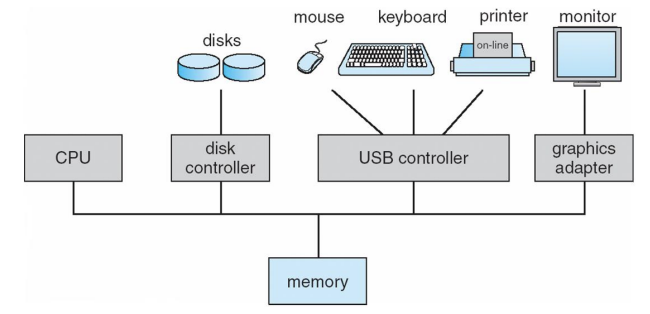
Computer-System Operation
- I/O devices and the CPU can execute concurrently
- Each device controller is in charge of a particular device type
- Each device controller has a local buffer
- CPU moves data from/to main memory to/from local buffers
- I/O is from the device to local buffer of controller
- Device controller informs CPU that it has finished its operation by causing an interrupt
Computer Startup
- bootstrap program is loaded at power-up or reboot
- bootstrap program: OS를 탑재시키는 프로그램(ROM에 저장되는 firmware)
- Typically stored in ROM or EPROM, generally known as firmware
- Initializes all aspects of system
- Loads operating system kernel and starts execution
- After OS starts, it waits for the event.
- OS는 능동적인 애가 아니라 외부에서 어떠한 서비스 요청이 들어왔을 때 반응하기에 이를 기다린다.
- Event driven system
- Occurrence of Event is signaled by (H/W or S/W) interrupt
- power failed -> hardware interrupt
Common Functions of Interrupts
- 외부에서 요청을 하지 않으면 OS는 일을 하지 않음
- Interrupt transfers control to the interrupt service routine, through the interrupt vector, which contains the addresses of all the interrupt service routines (ISR)
- Interrupt architecture must save the address of the interrupted instruction - ISR 실행 후 리턴을 위해
- 반드시 interrupt 됐을 당시 address를 save를 해 놔야 처리 후 다시 돌아갈 수 있음
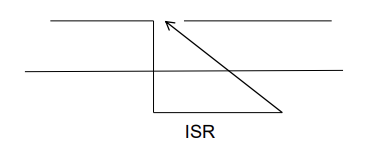
- A trap or exception is a software-generated interrupt caused either by an error or a user request
-
An operating system is interrupt driven
- system call - OS API
- 사용이 kernel 모드에서 일어남
- library 함수(printf와 같은)는 User mode 에서만 사용
- trap: OS 함수를 호출하기 위해서 발생되는 (software) interrupt
- trap마다 번호가 있어 해당하는 trap handler 실행 후 리턴
- exception - divide by zero: 프로그램에서 각종 error가 발생할 때의 software interrupt
Interrupt Handling
- The operating system preserves the state of the CPU by storing registers and the program counter (ISR 실행후 리턴시 원래 snapshot 복구)
- running snapshot
- Determines which type of interrupt has occurred:
- polling
- CPU에 interrupt가 걸렸다는 사실만 알려지고 누가 건지는 모름
- 초창기에 사용
- vectored interrupt system
- 어느 device가 interrupt를 걸면 CPU가 OK라는 응답을 보내고, 다시 device는 ok 사인에 대하여 interrupt vector를 memory에 write하는 것처럼 data bus에 실어 보낸다.
- polling
- Separate segments of code determine what action should be taken for each type of interrupt
Interrupt Timeline
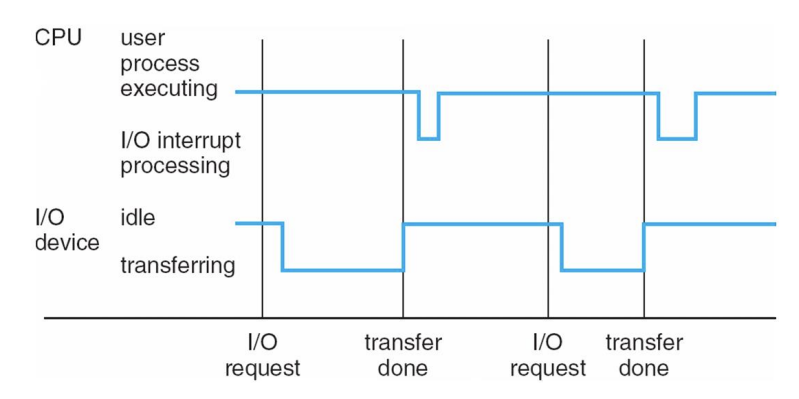
I/O device가 IO를 하고 있는 동안에도 CPU 역시 일을 하고 있음.(concurrent)
transfer done 단계에서 interrupt가 있었을 것이고 CPU에서는 ISR이 실행되는 구간이 있음
Storage Structure
- Main memory – only large storage media that the CPU can access directly
- Random access
- Typically volatile (power가 꺼지면 content가 날라감)
- Secondary storage(HDD, SDD) – extension of main memory that provides large nonvolatile storage capacity
- Hard disks – rigid metal or glass platters covered with magnetic recording material
- Disk surface is logically divided into tracks, which are subdivided into sectors
- The disk controller determines the logical interaction between the device and the computer
- Solid-state disks – faster than hard disks, nonvolatile
- Various technologies
- Becoming more popular
Storage Hierarchy
- Storage systems organized in hierarchy
- Speed
- Cost
- Volatility
- Caching – copying information into faster storage system; main memory can be viewed as a cache for secondary storage
- Device Driver for each device controller to manage I/O
- Provides uniform interface between controller and kernel
Storage-Device Hierarchy
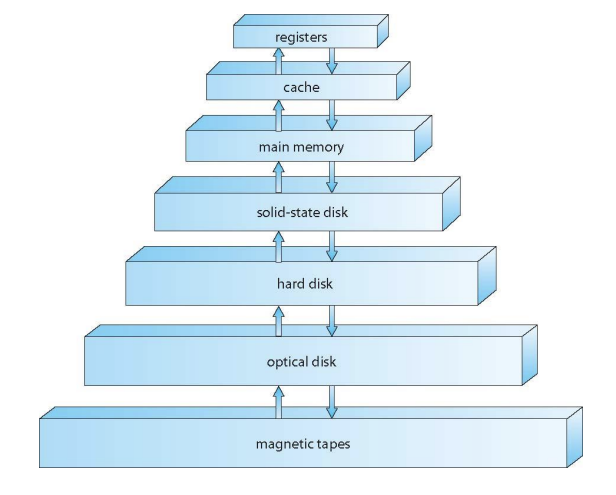
program을 실행시키기 위해서는 무조건 main memory에 탑재를 시켜야 함.
cache는 각 계층 사이마다 있을 수 있음
- 또한 여러 개가 이어져서 사용되기도 함
Caching
- Important principle, performed at many levels in a computer (in hardware, operating system, software)
- Information in use copied from slower to faster storage temporarily
- Faster storage (cache) checked first to determine if information is there
- If it is, information used directly from the cache (fast)
- If not, data copied to cache and used there
- Cache smaller than storage being cached
- Cache management is important design problem
- Cache size and replacement policy(무엇을 버릴지)
I/O Structure
- Computer-system consists of one or more CPUs and multiple device controllers connected through a common bus
- A device controller includes local buffer storage and a set of special purpose registers
- Device controller is responsible for moving data between the peripheral device it controls and its local buffer storage
- OS have a device driver for each device controller
- 각 device driver(disk, keyboard…) 마다 대화가 가능한 device controller가 있고 끼리끼리만 대화 가능
- device driver understands the device controller and provides OS with uniform interface to the device
- To start an Interrupt driven I/O operation,
- device driver loads the registers within device controller (command)
- device controller understands the commands by examining the contents of registers
- device controller transfers the data between device and local buffer
- Once data transfer is complete, device controller informs the device driver using interrupt (data transfer 종료 통보)
- Device driver returns control to OS, returning data or pointer to the data, status info.
Direct Memory Access Structure
CPU의 간섭없이 device to/from memory read/write하는 방법
- Used for high-speed I/O devices able to transmit information at close to memory speeds
- Device controller transfers blocks of data from buffer storage directly to main memory without CPU intervention
- Only one interrupt is generated per block, rather than the one interrupt per byte
How a Modern Computer Works
중요!!!
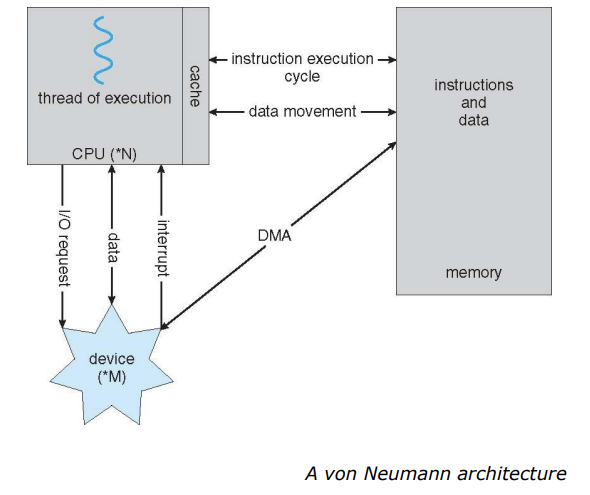
-
대부분의 컴퓨터는 이 구조
-
폰노이만 구조를 해치지 않으면서 좀 더 효율적으로 read/write
-
DMA
-
원래는 CPU가 device controller로부터 값을 읽어서 memory에 전달해야 하는데
-
DMA를 통해 device가 CPU는 쉬고 있을 때 어떤 data를 메모리에 가져다 놓겠다고 선언한 후 CPU 몰래 가져다 놓는 방식
-
- 가장 먼저 메모리에 탑재를 시켜야 함
- CPU가 한 번에 하나씩 명령(instruction)을 받아들여서
- 이 때, thread of execution이 여러 개가 될 수 있음 -> parallel processing
- I/O device + I/O controller
- CPU는 직접 IO하지 않음(HDD와 같이 엄청 느린 디바이스를 상대할 시간이 없음) -> device controller가 대신 control
- 그 때부터 CPU와 device controller는 parallel하게(각자) 돌아간다.
Von Neumann Architecture
- Stored Program concept
- Main memory storing programs and data
- Contents of memory are addressable by location
- Execution occurs sequentially (unless explicitly specified)
- PC - CPU가 갖고 있는 register
- 다음에 실행할 instruction의 주소를 가지고 있음
어떤 프로그램도 아래 세 가지를 벗어나지 않음
- sequence
- iteration
- selection
The Von Neumann Architecture
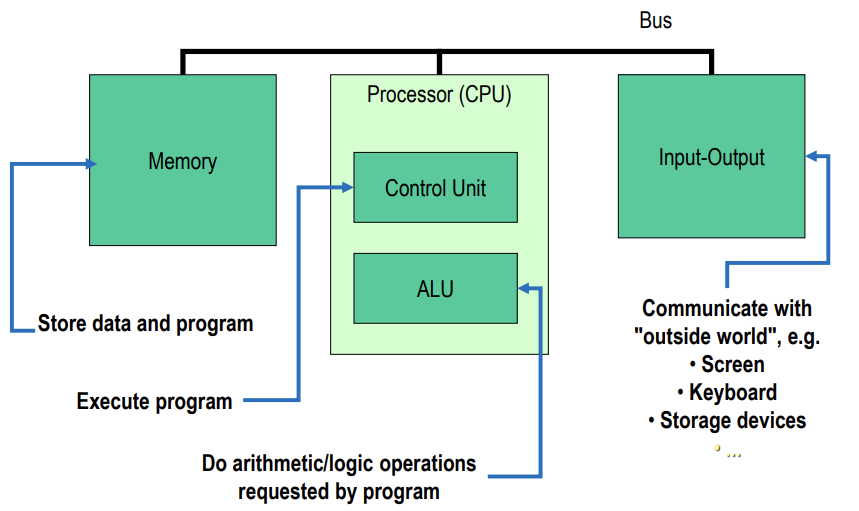
내부에서 고정적으로 사용되는 memory -> CPU regiseter
Instruction Cycle
- Two steps:
- Fetch
- Execute

-
instruction cycle = 한 문장을 실행하는 한 cycle
-
왜 main memory에 탑재해야 하는가?
- CPU internal 메모리는 비싸기 때문에 많은 메모리를 탑재하지 못하고
- HDD는 속도가 너무 느리기 때문이다.
중요!!!
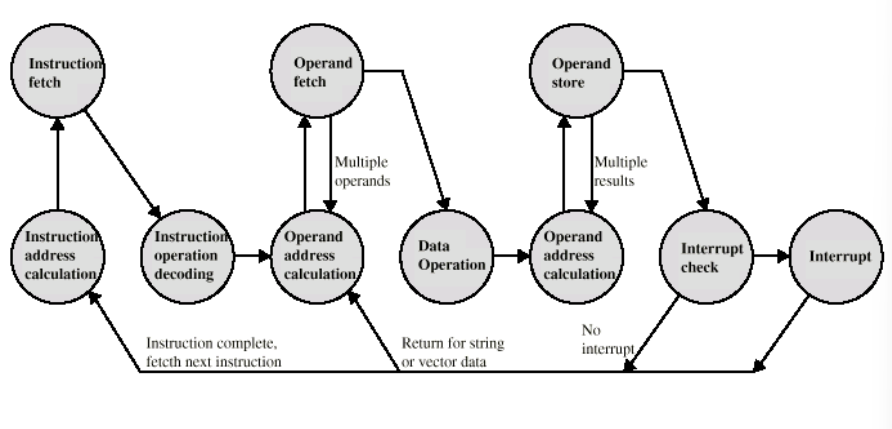
Computer-System Architecture
- Single-processor systems
- Most systems use a single general-purpose processor
- Most systems have special-purpose processors as well (device specific)
- Multiprocessor systems growing in use and importance
- Also known as parallel systems(multi-core), tightly-coupled systems
- Tightly-coupled system – processors share memory and a clock; communication usually takes place through the shared memory in close area(제한된 영역 내에서 공유되는)
- Advantages include:
- Increased throughput (Speedup)
- Economy of scale – cost less than multiple single-processor systems
- Increased reliability – graceful degradation or fault tolerance (duplication)
- Two types:
- Asymmetric Multiprocessing
- Symmetric Multiprocessing
- Symmetric multiprocessing (SMP)
- Each processor runs an identical copy of the operating system.
- Many processes can run at once without performance deterioration.
- Load balancing is important
- 예를 들어 채점을 두 명이서 나눠서 하는데 한 사람은 만 명에 대한 걸 하고 한 사람은 10명에 대한 채점을 한다면 밸런싱이 맞지 않아 비효율이 발생할 것이기 때문이다.
- Most modern operating systems support SMP
- Asymmetric multiprocessing
- Each processor is assigned a specific task; master processor schedules and allocates work to slave processors.
- More common in extremely large systems
Symmetric Multiprocessing Architecture
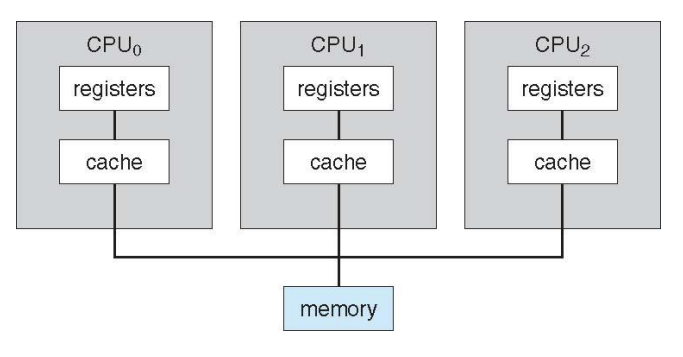
master-slave 관계가 아닌 동등한 관계
dependent 관계의 CPU들이 같이 일을 함.(memory를 공유하기 때문에)
A Dual-Core Design
- Memory access model: UMA(uniform memory access ) and NUMA architecture variations
- Multiprocessing increases computing power by adding CPUs
- Adding CPUs also increases amount of memory addressable
- NUMA(non-uniform): 각 CPU가 memory에서 자주쓰는 내용을 가져와서 사용함.
- Multi-chip and multicore
- Blade server systems
- Chassis containing multiple independent multiprocessor systems
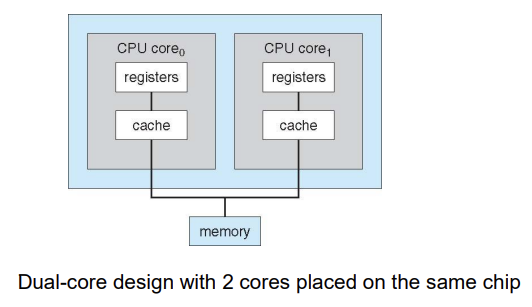
Clustered Systems
- 좀 더 독립성이 부여된 시스템들끼리 모여 있는 경우
- Another type of multiprocessor system
- multiple independent nodes working together
- Each node may be a single-processor system or multi-core system
- Loosely-coupled system, closely linked via LAN (Ethernet) or InfiniBand
- Usually sharing storage via a storage-area network (SAN)
- Provides a high-availability(HA) service which survives failures
- Asymmetric clustering has one machine in hot-standby mode
- Symmetric clustering has multiple nodes running applications, monitoring each other
- Some clusters are for high-performance computing (HPC)
- Applications must be written to use parallelization
- Other forms of Clusters
- Parallel cluster or clustering over WAN
- Some have distributed lock manager (DLM) to avoid conflicting operations
Clustered Systems
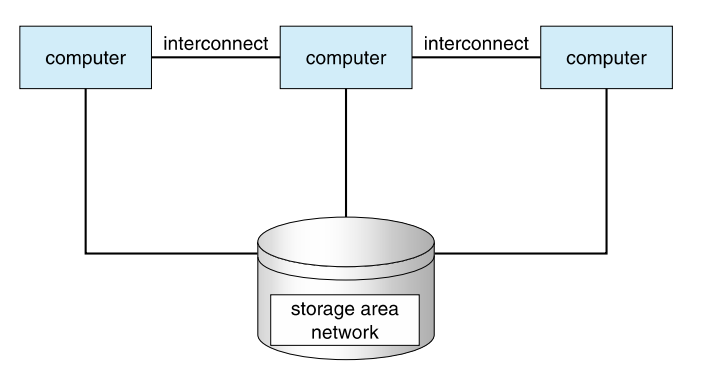
Distributed Systems
- Distribute the computation among several physical processors.
- Loosely coupled system – each processor has its own local memory; processors communicate with one another through various communications lines.
- Advantages of distributed systems.
- Resources Sharing
- Computation speed up – load sharing
- Reliability
- Communications
- Requires networking infrastructure.
- Local area networks (LAN) or Wide area networks (WAN)
- May be either client-server or peer-to-peer systems.
(생략)
- Network Operating System
- provides file sharing
- provides communication scheme
- runs independently from other computers on the network
- Distributed Operating System
- less autonomy between computers
- gives the impression there is a single operating system controlling the network.
Operating System Structure
- Multiprogramming (Batch system) needed for efficiency (non-preemptive multiprogramming)
- Single user cannot keep CPU and I/O devices busy at all times
- Multiprogramming organizes jobs (code and data) so CPU always has one to execute
- A subset of total jobs in system is kept in memory (job pool)
- One job selected and run via job scheduling
- job scheduling: 누가 먼저 스케쥴링 될 것인지
- When it has to wait (for I/O for example), OS switches to another job
- Timesharing (multitasking) is logical extension in which CPU switches jobs so frequently that users can interact with each job while it is running, creating interactive computing
- Response time should be < 1 second
- good response time!
- Each user has at least one program executing in memory => process
- If several jobs ready to run at the same time => CPU scheduling
- If processes don’t fit in memory, swapping moves them in and out to run
- Virtual memory allows execution of processes not completely in memory
- Response time should be < 1 second
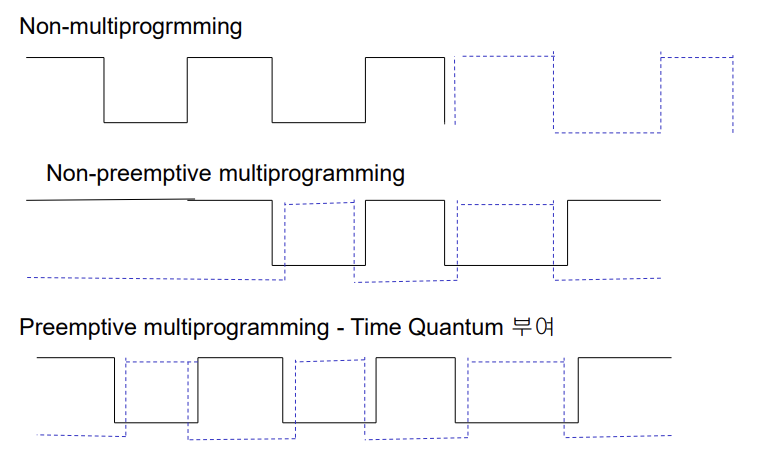
- Non-multiprogramming:
- 한 프로그램이 끝나고 다른 프로그램이 실행.
- CPU가 일을 하지 않고 놀고 있는 구간이 존재(CPU Time의 낭비)
- Non-preemptive multiprogramming
- CPU가 놀고 있는 구간을 활용하여 다른 프로그램을 실행시킴
- CPU가 쉬지 않고 일을 하여 시스템의 효율이 올라감
- CPU와 I/O device가 동시에 활용되는 경우가 생길 수 있음
- I/O를 하지 않는 동안에 CPU를 굉장히 오래 붙잡고 있어도 크게 문제가 되지 않는다.
- non preemptive - 강제로 빼앗지 않는
- I/O를 하기 위해서 자발적으로 내놓지 않으면 다른 프로그램이 실행될 수 없음
- pseudo parallel processing (실제로 둘이 같이 돌지 않기 때문에)
- Preemptive multiprogramming - Time Quantum 부여
- 어떤 프로그램이 CPU에서 실행이 되는데 CPU에서 실행될 수 있는 최대 시간이 바로 time quantum이다.
- time quantum 시간 동안만 CPU를 사용하는 것을 허락한다.
- I/O를 하지 않아도 CPU를 빼앗아서 동시에 다른 프로그램을 번갈아가면서 실행시킬 수 있음
- 만약 time quantum이 굉장히 커지게 되면 Non-preemptive 에 가까워 짐.
- 만약 time quantum이 굉장히 작아지게 되면 interaction은 굉장히 올라가는 대신에 시스템 성능은 오히려 Non-preemptive 보다 안 좋아 지게 된다.
- 그래서 적정한 값을 정하는 것이 중요함
Memory Layout for Multiprogrammed System
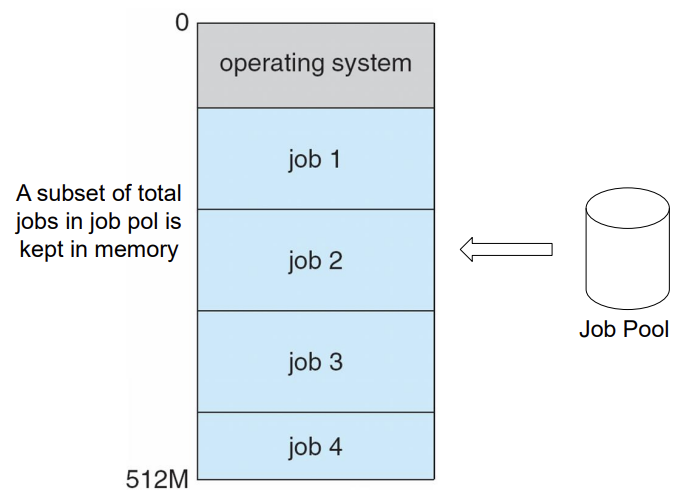
- 어떤 job(program)을 먼저 탑재시킬 지를 정하는 것이 job scheduling
- 탑재된 job들 중에서 누가 먼저 CPU를 차지할 지를 결정하는 것이 CPU scheduling
- swapping: 탑재된 job들 중에서 별로 시급하지 않은 job의 경우 hard disk job pool에 보내고(swap out) 더 중요한 job을 job pool(swap in)로부터 불러 들인다.
Operating-System Operations
- Interrupt driven (hardware and software)
- Hardware interrupt by one of the devices (외부 디바이스에 의한)
- Software interrupt (exception or trap):
- exception: Software error (e.g., division by zero)
- trap: Request for operating system service(시스템 콜을 호출하는 경우)
- Other process problems include infinite loop, processes modifying each other or the operating system
- 정상적으로 실행되는 것처럼 보이지만 무한 루프를 돌고 있는 경우(interrupt 검출이 되지 않음)
- 이를 잡아낼 수 있는 tool이 있어야 함(아래와 같이)
- Basic tools to Ensure correct operation of computer system
- Dual mode - user가 kernel의 권한을 행사하지 못하도록 하는 것
- Privileged instruction
- Memory protection
- 프로그램이 OS 영역을 침범하거나 다른 프로그램을 침범하는 것을 catch하여 interrupt를 걸어 OS에 통보
- Timer interrupt – infinite loops
- 일정 시간이 경과하면 걸리는 interrupt
- Dual-mode operation allows OS to protect itself and other system components
- User mode and kernel mode
- Mode bit provided by hardware (mode를 판단하기 위한 bit)
- Provides ability to distinguish when system is running user code or kernel code
- Some instructions designated as privileged, only executable in kernel mode
- 일부는 user mode에서 실행되지 않음(시스템에 심각한 문제를 야기하는 것을 방지하기 위함)
- System call changes mode to kernel, return from call resets it to user
- Increasingly CPUs support multi-mode operations
- i.e. virtual machine manager (VMM) mode for guest VMs
Transition from User to Kernel Mode
- Timer to prevent infinite loop / process hogging resources
- Timer is set to interrupt the computer after some time period
- Keep a counter that is decremented by the physical clock.
- Operating system set the counter (privileged instruction)
- When counter zero generate an interrupt -> 프로그램이 무한 루프를 돌고있다고 판단
- OS 자원을 낭비, CPU time 낭비
- Set up before scheduling process to regain control or terminate program that exceeds allotted time
- 종료 시켜 컴퓨터 자원 회수
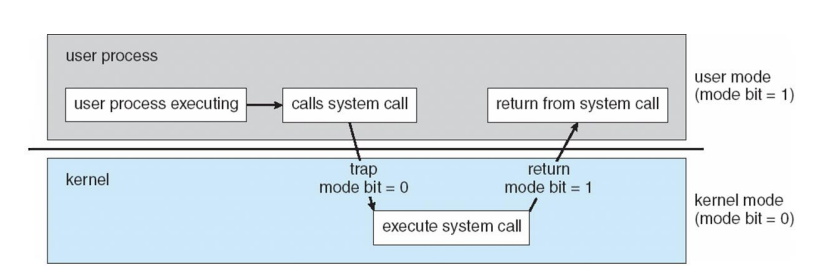
Process Management(중요)
program definition은 어떤 프로그램의 모양(붕어빵틀) - 실행 파일
program definition이 만들어내는 instance가 process(msword 창을 두 개 띄우는 경우 ‘하나의 program definition에서 두 개의 process가 생겼다’라고 한다.; 틀로 찍어낸 붕어빵 두 개)
- A process is a program in execution. It is a unit of work within the system. Program is a passive entity, process is an active entity.
- 프로세스는 실제로 실행되고 있는 상태이기 때문에 active entity인 것.
- 변수 x도 선언 시에 메모리에 할당되는 것이 아니라 프로세스가 실행되면 할당 된다.
- Process needs resources to accomplish its task
- CPU, memory, I/O, files
- Initialization data
- Process termination requires reclaim of any reusable resources
Single-threaded processhas one program counter specifying location of next instruction to execute- 하나의 process에 하나의 program counter
- program counter가 갖는 값의 궤적이 바로 thread
- Process executes instructions sequentially, one at a time, until completion
Multi-threaded processhas one program counter per thread- Typically system has many processes, some user, some operating system running concurrently on one or more CPUs
- Concurrency by multiplexing the CPUs among the processes / threads
- CPU가 여러개인 경우 -> parallel processing
- CPU가 하나인 경우 -> pseudo parallel processing
- CPU 하나를 공유하면서 차지해야 하기 때문
Process Management Activities
The operating system is responsible for the following activities in connection with process management:
- Creating and deleting both user and system processes
- Suspending and resuming processes
- 프로세스가 계속 실행되는 것이 아니라 I/O를 해야 하기 때문에 I/O가 한 번 실행되고(suspend) 종료될 때(resume)까지 CPU에 의해 실행이 될 수 없다.
- Providing mechanisms for process synchronization
- 동일한 계좌에 대한 동기화
- Providing mechanisms for process communication (IPC- inter process ?)
- Providing mechanisms for deadlock handling
- 동기화를 하다가 잘못되면 두 프로세스 모두가 실행이 되지 않는 경우(둘 중 어느 프로세스도 이도저도 못하는 상황) 가 발생하는데
- 검출하여 해결하는 것이 process management의 역할
Memory Management
- To execute a program all (or part) of the instructions must be in memory
- All (or part) of the data that is needed by the program must be in memory.
- Memory management determines what is in memory and when
- Optimizing CPU utilization and computer response to users
- Memory management activities
- Keeping track of which parts of memory are currently being used and by whom
- Deciding which processes (or parts thereof) and data to move into and out of memory
- Allocating and deallocating memory space as needed
Storage Management
secondary memory
- OS provides uniform, logical view of information storage (3차원적 주소를 1차원으로 생각할 수 있도록 해 주는 역할)
- Abstracts physical properties to logical storage unit - file
- Each medium is controlled by device (i.e., disk drive, tape drive)
- Varying properties include access speed, capacity, data-transfer rate, access method (sequential or random)
- File-System management
- Files usually organized into directories
- Access control on most systems to determine who can access what
- OS activities include
- Creating and deleting files and directories
- Primitives to manipulate files and directories
- Mapping files onto secondary storage
- Backup files onto stable (non-volatile) storage media
Mass-Storage Management(생략)
- Usually disks used to store data that does not fit in main memory or data that must be kept for a “long” period of time
- Proper management is of central importance
- Entire speed of computer operation hinges on disk subsystem and its algorithms
- OS activities
- Free-space management
- Storage allocation
- Disk scheduling
- Some storage need not be fast
- Tertiary storage includes optical storage, magnetic tape
- Still must be managed – by OS or applications
- Varies between WORM (write-once, read-many-times) and RW (read-write)
Performance of Various Levels of Storage
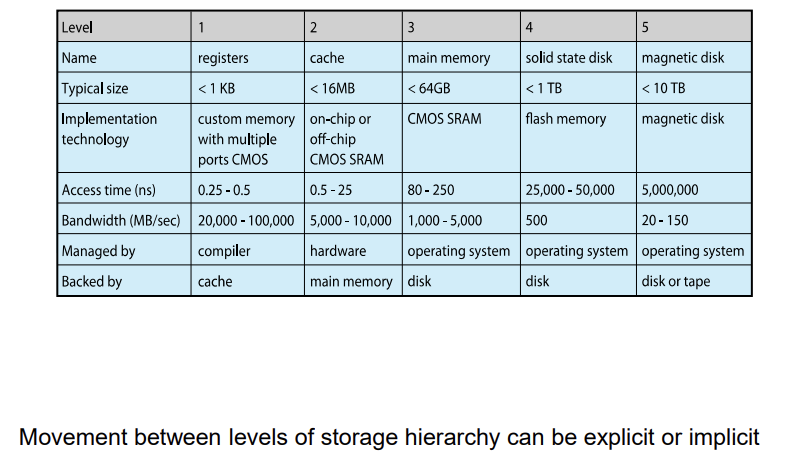
Migration of data “A” from Disk to Register
- Multitasking environments must be careful to use most recent value, no matter where it is stored in the storage hierarchy

- Multiprocessor environment must provide cache coherency in hardware such that all CPUs have the most recent value in their cache
- multiprocessing 환경에서 더 어려운 과제 (하지만 중요한 OS의 필수 역할)
- Distributed environment situation even more complex
- Several copies of a datum can exist
- Various solutions covered in Chapter 17
I/O Subsystem
- One purpose of OS is to hide peculiarities of hardware devices from the user
- I/O subsystem responsible for
- Memory management of I/O including buffering (storing data temporarily while it is being transferred), caching (storing parts of data in faster storage for performance), spooling (the overlapping of output of one job with input of other jobs)
- General device-driver interface
- Drivers for specific hardware devices
Protection and Security
- Protection – any mechanism for controlling access of processes or users to resources defined by the OS
- Security – defense of the system against internal and external attacks
- Huge range, including denial-of-service, worms, viruses, identity theft, theft of service
- Systems generally first distinguish among users, to determine who can do what
- User identities (user IDs, security IDs) include name and associated number, one per user
- User ID then associated with all files, processes of that user to determine access control
- Group identifier (group ID) allows set of users to be defined and controls managed, then also associated with each process, file
- Privilege escalation(단계적 확대) allows user to change to effective ID with more rights
Computing Environments - Traditional Computing
- Stand-alone general purpose machines (network가 없던 시절)
- But blurred as most systems interconnect with others (i.e., the Internet)
- Office environment
- PCs connected to a network, terminals attached to mainframe or minicomputers providing batch and timesharing
- Now portals allowing networked and remote systems access to same resources
- Home networks
- Used to be single system, then modems
- Office environment
- Portals provide web access to internal systems
- Network computers (thin clients) are like Web terminals
- memory가 굉장히 적은 컴퓨터 (단순한)
- Mobile computers interconnect via wireless networks
- Networking becoming ubiquitous – even home systems use firewalls to protect home computers from Internet attacks
Computing Environments - Mobile Computing
- Handheld systems
- smartphones, tablets, etc
- What is the functional difference between them and a “traditional” laptop?
- Reduced feature set OS, limited I/O, limited CPU, memory, power
- Extra feature – more OS features (GPS, gyroscope)
- Allows new types of apps like augmented reality(AR)
- Use IEEE 802.11 wireless, or cellular data networks for connectivity
- Leaders are Apple iOS and Google Android
Computing Environments – Distributed Systems
- Distributed computiing
- Collection of separate, possibly heterogeneous, systems networked together
- Network is a communications path, TCP/IP most common
- Local Area Network (LAN)
- Wide Area Network (WAN)
- Metropolitan Area Network (MAN)
- Personal Area Network (PAN)
- Network is a communications path, TCP/IP most common
- Network Operating System provides features between systems across network
- Communication scheme allows systems to exchange messages
- Illusion of a single system
- Collection of separate, possibly heterogeneous, systems networked together
Computing Environments – Client-Server Computing
- Client-Server Computing
- Dumb terminals supplanted by smart PCs
- Many systems now servers, responding to requests generated by clients
- Compute-server system provides an interface to client to request services (i.e., database)
- File-server system provides interface for clients to store and retrieve files
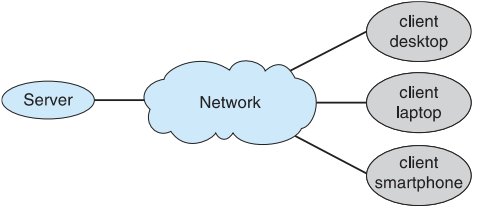
Computing Environments - Peer-to-Peer Computing
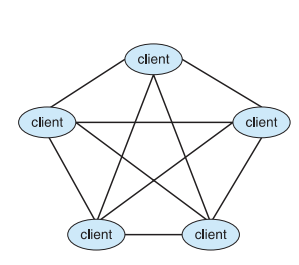
- Another model of distributed system
- P2P does not distinguish clients and servers
- Instead all nodes are considered peers
- May each act as client, server or both
- Node must join P2P network
- Registers its service with central lookup service on network, or
- Broadcast request for service and respond to requests for service via discovery protocol
- Examples include Napster and Gnutella, Voice over IP (VoIP) such as Skype
Computing Environments - Virtualization
- Allows operating systems to run applications as applications within other OS
- Vast and growing industry
- Emulation used when source CPU type different from target type (i.e. PowerPC to Intel x86)
- Generally slowest method
- When computer language not compiled to native code – Interpretation
- Every machine-level instruction that runs natively on source system must be translated to equivalent functions of target system
- Virtualization – OS natively compiled for CPU, running guest OSes also natively compiled
- Consider VMware running WinXP guests, each running applications, all on native WinXP host OS
- VMM (virtual machine Manager) provides virtualization services
- Use cases involve laptops and desktops running multiple OSes for exploration or compatibility
- Apple laptop running Mac OS X host, Windows as a guest
- Developing apps for multiple OSes without having multiple systems
- QA testing applications without having multiple systems
- Executing and managing compute environments within data centers
- VMM can run natively, in which case they are also the host
- There is no general purpose host then (VMware ESX and Citrix XenServer)
Virtual Machines
- A virtual machine takes the layered approach to its logical conclusion. It treats hardware and the operating system kernel as though they were all hardware.
- A virtual machine provides an interface identical to the underlying bare hardware.
- The operating system host creates the illusion that a process has its own processor and (virtual memory).
- Each guest provided with a (virtual) copy of underlying computer.
Computing Environments - Virtualization
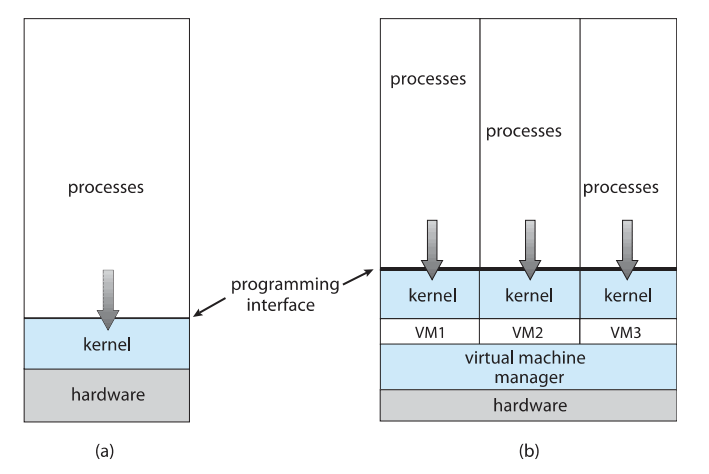
virtual machine manager
- 가상화를 해 주고 관리하는
여러 개의 실행환경이 생김
VMware Architecture
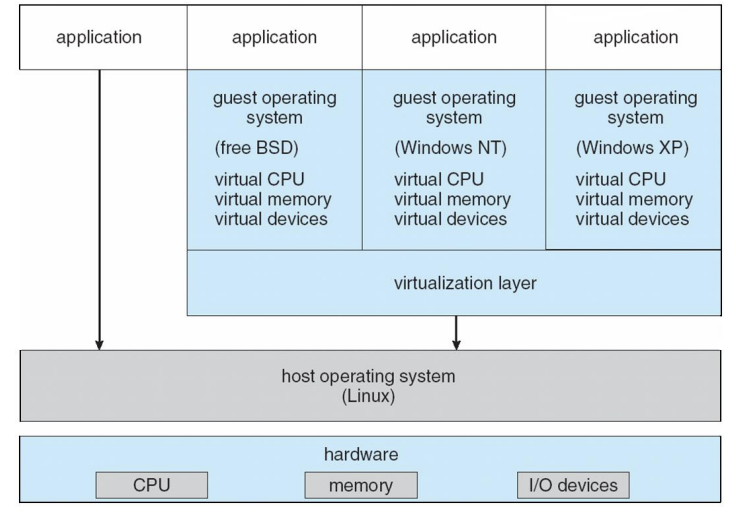
hardware위에 OS가 있고 그 위에 가상화 layer가 존재하는
application 별로 가상화 종류가 다 다름
The Java Virtual Machine
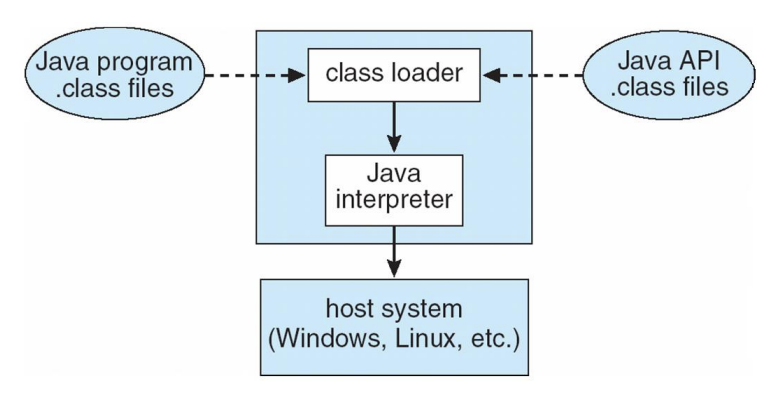
Computing Environments – Cloud Computing
- Delivers computing, storage, even apps as a service across a network
- Logical extension of virtualization because it uses virtualization as the base for it functionality.
- Amazon EC2 has thousands of servers, millions of virtual machines, petabytes of storage available across the Internet, pay based on usage
- Many types
- Public cloud – available via Internet to anyone willing to pay
- Private cloud – run by a company for the company’s own use
- Hybrid cloud – includes both public and private cloud components
- Software as a Service (SaaS) – one or more applications available via the Internet (i.e., word processor)
- Platform as a Service (PaaS) – software stack ready for application use via the Internet (i.e., a database server)
- 플랫폼 자체를 서비스로 제공
- Infrastructure as a Service (IaaS) – servers or storage available over Internet (i.e., storage available for backup use)
- Infrastructure를 대여해 주는 서비스
- Cloud computing environments composed of traditional OSes, plus VMMs, plus cloud management tools
- Internet connectivity requires security like firewalls
- Load balancers spread traffic across multiple applications
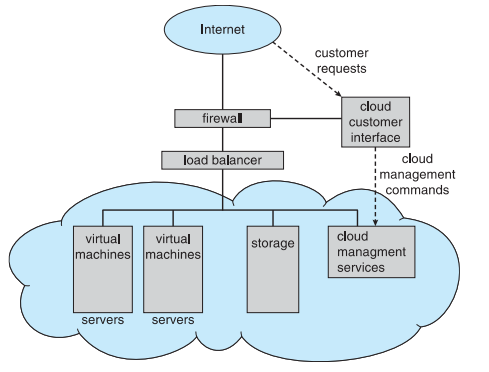
load balancer - 적절하게 load를 분배해야 최대 성능을 얻을 수 있음
Computing Environments – Real-Time Embedded Systems
- Real-time embedded systems most prevalent form of computers
- Car engine, manufacturing robots, Multimedia systems, network of diverse devices
- real-time OS
- Reduced feature set OS, limited user interface
- Various embedded systems (보통 임베디드 시스템에 있음, not 범용 컴퓨터)
- Some general-purpose computers with standard OS with special-purpose applications
- Some hardware devices with a special-purpose embedded OS
- some hardware devices with ASIC that perform tasks without an OS
- Real-time OS has well-defined fixed time constraints
- Processing must be done within constraint
- Correct operation only if constraints met
Real-Time Systems
- Often used as a control device in a dedicated application such as controlling scientific experiments, medical imaging systems, industrial control systems, and some display systems.
- 단순히 빠르기만 한 게 real-time os가 아님.
- Well-defined fixed-time constraints.
- time sharing systems : fast response
- Batch system: no time constraints
Hard real-time system- Secondary storage limited or absent, data stored in short-term memory, or read-only memory (ROM)
- Conflicts with time-sharing systems, not supported by general-purpose operating systems.
- 제한된 시간 안에 이벤트 처리가 100% 보장되는 시스템
Soft real-time system- Limited utility in industrial control or robotics
- Useful in applications (multimedia, virtual reality) requiring advanced operating-system features.
- ex. 전화 교환기
- 제한된 시간 안에 이벤트 처리가 100% 보장되지는 않지만 대부분 처리는 되는 시스템
Open-Source Operating Systems
- Operating systems made available in source-code format rather than just binary closed-source
- Linux, Windows
- Counter to the copy protection and Digital Rights Management (DRM) movement
- Started by Free Software Foundation (FSF), which has “copyleft” GNU Public License (GPL)
- Examples include GNU/Linux and BSD UNIX (including core of Mac OS X), and many more
- Can use VMM like VMware Player (Free on Windows), Virtualbox (open source and free on many platforms - http://www.virtualbox.com)
- Use to run guest operating systems for exploration
- I recommend to read textbook.

댓글남기기